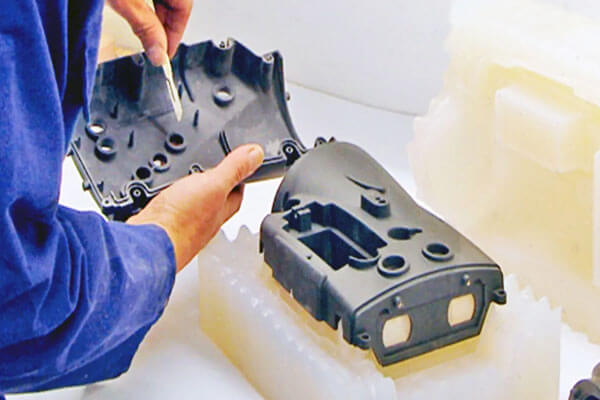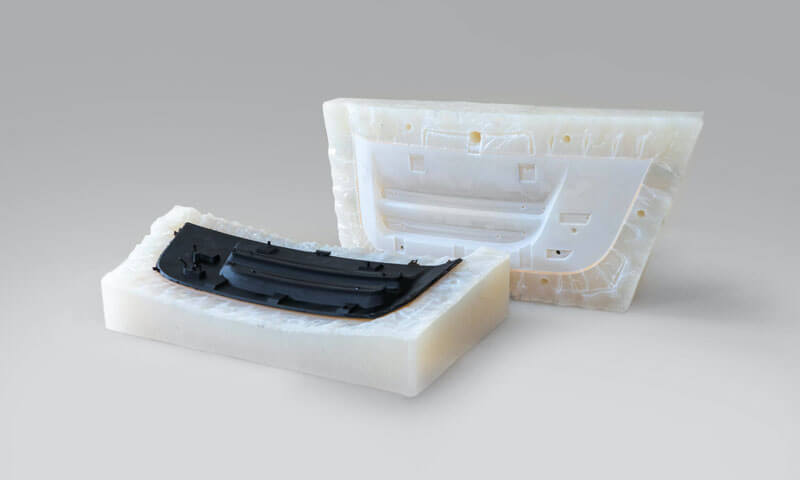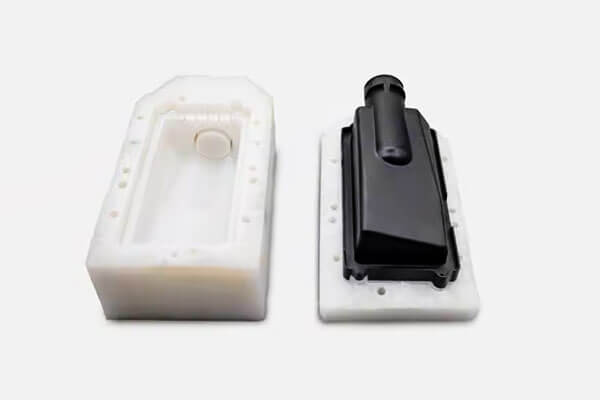1. Introduction
Vacuum casting has established itself as a leading manufacturing technique for producing high-quality prototypes and low-volume production parts.
Renowned for its precision, versatility, and ability to replicate intricate details, this process plays a vital role in industries such as automotive, aerospace, medical devices, and consumer electronics.
By utilizing silicone molds and liquid resins, vacuum casting delivers components that closely resemble injection-molded parts in terms of mechanical properties and surface finish.
This makes it a crucial bridge between rapid prototyping and full-scale manufacturing.
In this article, we will explore the fundamentals of vacuum casting, the materials involved, the step-by-step process, key applications, and the latest innovations shaping the future of this technique.
2. Understanding Vacuum Casting
Definition and Overview
Vacuum casting, also known as urethane casting, is a manufacturing process that uses a vacuum environment to fill a mold with liquid resin.
The process is particularly effective in eliminating air bubbles, ensuring that the final product has high structural integrity and a smooth surface finish.
Unlike traditional casting techniques, vacuum casting excels in replicating fine details from a master model, making it ideal for rapid prototyping and small-batch production.

How Vacuum Casting Works
The process begins with the creation of a master model, typically produced using CNC machining or 3D printing. This master model serves as the reference for making a silicone mold.
Once the mold is ready, it is filled with liquid resin under vacuum conditions to prevent defects such as porosity and air entrapment.
The resin is then cured in an oven, solidifying into a durable and precise replica of the original model.
Key Characteristics
Vacuum casting stands out due to several defining characteristics:
- Exceptional Detail Reproduction: Captures fine textures and intricate geometries.
- High-Quality Surface Finish: Produces smooth parts that require minimal post-processing.
- Material Versatility: Can replicate the mechanical properties of thermoplastics and elastomers.
- Cost-Effective for Low-Volume Production: Eliminates the need for expensive tooling, reducing upfront costs.
3. The Vacuum Casting Process: Step-by-Step
Vacuum casting is a highly efficient method for producing high-quality plastic and rubber prototypes with exceptional detail and precision.
This section will break down the vacuum casting process step-by-step, from the initial master model preparation to the final casting and post-processing.
3.1. Creating the Master Model
The vacuum casting process begins with the fabrication of a master model, which serves as the reference for producing silicone molds.
The master model must have an accurate shape, smooth surface finish, and precise dimensions to ensure high-quality duplication.
Common Methods for Creating Master Models:
- CNC Machining: Produces highly precise models from plastic or metal.
- 3D Printing (SLA or SLS): A cost-effective and rapid method for complex designs.
- Hand-Crafted Prototypes: Used for highly customized or artistic designs.
3.2. Mold Preparation Using Silicone Rubber
After the master model is ready, a silicone mold is created to form the cavity for casting replicas. The process involves:
- Encasing the Master Model: The master model is placed in a casting box, and liquid silicone rubber is poured around it.
- Curing the Silicone: The mold is placed in a vacuum chamber to remove air bubbles, ensuring a defect-free mold.
Curing typically takes 8–24 hours, depending on the silicone type and curing method (room temperature or heated). - Cutting the Mold: Once cured, the mold is carefully cut open along a pre-planned seam, and the master model is removed, leaving a hollow cavity that replicates its shape.
3.3. Material Selection for Casting
Before casting, the appropriate polyurethane resin or rubber-like elastomer is selected based on the desired mechanical properties, transparency, or heat resistance.
Different formulations can mimic ABS, polycarbonate, PP, nylon, or soft rubber materials.
Common factors considered when selecting a resin:
- Mechanical Strength (e.g., rigid vs. flexible materials)
- Thermal Resistance (for applications in high-temperature environments)
- Optical Transparency (needed for lenses or display covers)
- Chemical Resistance (for industrial applications exposed to harsh conditions)
3.4. Vacuum Casting and Resin Pouring
The core step of the process involves casting the liquid resin into the silicone mold under vacuum conditions to eliminate air bubbles and ensure a defect-free final product.
- Preheating the Mold: The silicone mold is heated to prevent warping and ensure even curing.
- Mixing and Degassing the Resin: The chosen polyurethane resin is mixed and placed in a vacuum chamber to remove trapped air.
- Pouring the Resin: The vacuum chamber is activated to remove air from the mold, allowing the resin to fill every detail of the cavity.
- Curing the Cast Part: The filled mold is placed in an oven at 60–70°C for 30–120 minutes to cure the resin.
Vacuum Casting Process
3.5. Demolding and Finishing
After curing, the cast part is carefully removed from the silicone mold. Thanks to the flexibility of silicone, even complex geometries with undercuts can be demolded without damage.
The raw casting undergoes post-processing to enhance appearance and performance:
Common Finishing Techniques:
- Trimming & Cleaning: Excess material or mold lines are removed.
- Sanding & Polishing: To achieve smooth surface finishes.
- Painting & Coating: Parts can be painted or UV-coated for durability.
- Assembly: If multiple components are cast, they are assembled as per design specifications.
Quality Control and Inspection
To ensure that the vacuum-cast parts meet design specifications and functional requirements, quality control checks are performed:
Inspection Methods:
- Dimensional Accuracy Testing: Using calipers, CMM (Coordinate Measuring Machines), or 3D scanning.
- Material Property Testing: Tensile strength, hardness, and impact resistance tests.
- Surface Finish Inspection: Checking for defects like bubbles, warping, or incomplete fills.
Summary of the Vacuum Casting Process
| Step | Key Actions | Purpose |
|---|---|---|
| Step 1: Master Model Creation | CNC machining or 3D printing of the prototype | Ensures precise replication of the desired shape |
| Step 2: Silicone Mold Making | Encasing the master model in silicone, curing, and cutting the mold | Creates a reusable mold for multiple castings |
| Step 3: Material Selection | Choosing polyurethane resins based on application needs | Matches the properties of final production materials |
| Step 4: Vacuum Casting | Resin is mixed, degassed, and poured under vacuum | Eliminates air bubbles and ensures defect-free casting |
| Step 5: Demolding & Finishing | Removing the part, sanding, painting, and assembling | Enhances aesthetics and functionality |
| Step 6: Quality Control | Inspection of dimensions, mechanical properties, and surface quality | Ensures accuracy and consistency |
4. Materials Used in Vacuum Casting
Material selection plays a critical role in vacuum casting, as different resins offer varied mechanical properties, thermal resistance, flexibility, and optical clarity.
Unlike traditional casting processes, vacuum casting utilizes polyurethane (PU) resins and silicone molds to replicate plastic and rubber components with high precision.
Choosing the right material ensures that the final product meets the required functional and aesthetic standards.
In this section, we will explore the key materials used in vacuum casting, including their characteristics, advantages, and typical applications.

Silicone Molds: The Foundation of Vacuum Casting
Silicone rubber is the preferred material for making molds in vacuum casting due to its flexibility, heat resistance, and excellent detail reproduction.
These molds serve as a cost-effective alternative to metal tooling and can be used to produce multiple high-quality castings before degradation occurs.
Key Properties of Silicone Molds
- High Elasticity: Allows for easy demolding without damaging delicate features.
- Excellent Detail Replication: Captures fine textures and intricate geometries.
- Heat and Chemical Resistance: Withstands the curing process of polyurethane resins.
- Limited Lifespan: Typically produces 20–30 parts before requiring replacement.
Polyurethane Resins: The Core Casting Material
Polyurethane resins are the primary materials used in vacuum casting, offering a diverse range of properties that can mimic industrial plastics like ABS, polycarbonate, and rubber.
Depending on the application, different types of PU resins are selected for their mechanical strength, flexibility, transparency, or heat resistance.
Types of Polyurethane Resins Used in Vacuum Casting
| Resin Type | Key Characteristics | Common Applications |
|---|---|---|
| Rigid Polyurethane Resins | Strong, impact-resistant, good machinability | Automotive components, electronic housings, functional prototypes |
| Flexible Polyurethane Resins | High elasticity, tear-resistant, rubber-like feel | Gaskets, seals, medical device components |
| Transparent Polyurethane Resins | High optical clarity, UV-resistant variants available | Lenses, light covers, transparent prototypes |
| High-Temperature Polyurethane Resins | Withstands heat up to 150°C–200°C, durable | Under-the-hood automotive parts, aerospace components |
| Flame-Retardant Polyurethane Resins | Meets fire safety standards, low smoke emission | Electrical enclosures, industrial safety components |
Specialty Materials for Enhanced Performance
Glass-Filled Polyurethane Resins
Adding glass fibers to polyurethane resins enhances mechanical strength, stiffness, and dimensional stability.
These materials are ideal for applications requiring high wear resistance and structural integrity.
Rubber-like Elastomers
For applications requiring flexibility and resilience, rubber-like polyurethane resins are used.
These materials offer varying Shore hardness levels, from soft silicone-like textures to firm rubber characteristics.
UV-Resistant and Weatherproof Resins
Certain polyurethane resins are designed to resist UV degradation and environmental wear, making them suitable for outdoor applications or products exposed to prolonged sunlight.
5. Advantages of Vacuum Casting
Vacuum casting offers several advantages over other manufacturing processes, particularly when it comes to prototyping and small-scale production.
- Superior Accuracy and Detail – The silicone molds used in vacuum casting can capture microscopic surface details, making the final parts highly precise.
- Shorter Lead Times – Unlike injection molding, which requires extensive tooling, vacuum casting allows for rapid mold production, reducing turnaround time to just a few days.
- Lower Costs for Small Batches – Since silicone molds are significantly cheaper than metal molds used in injection molding, vacuum casting is an economical choice for low-volume production.
- Broad Material Selection – Manufacturers can choose from a variety of resins, including rigid, flexible, transparent, and heat-resistant materials.
- Minimal Material Waste – The process ensures efficient resin utilization, reducing scrap and material wastage.
Additionally, vacuum casting enables designers to test multiple iterations of a product before committing to mass production, ensuring optimal functionality and design refinement.
6. Key Applications of Vacuum Casting
Vacuum casting serves multiple industries due to its ability to produce high-quality prototypes and functional parts.
| Industry | Applications |
|---|---|
| Automotive | Prototyping dashboards, trims, and engine components. |
| Aerospace | Cabin interior prototypes, control panel enclosures. |
| Medical & Healthcare | Custom prosthetics, medical device casings. |
| Consumer Electronics | Smartphone housings, wearables, remote control cases. |
| Industrial Equipment | Functional testing parts, machine enclosures. |
| Luxury Goods | High-end product models, intricate jewelry prototypes. |
7. Vacuum Casting vs. Other Manufacturing Methods
| Feature | Vacuum Casting | Injection Molding | 3D Printing | CNC Machining |
|---|---|---|---|---|
| Tooling Cost | Low | High | None | None |
| Production Speed | Fast for low volumes | Fast for mass production | Moderate | Moderate |
| Material Options | Wide range of resins | Extensive plastics | Limited | Wide range |
| Surface Finish | Excellent | Excellent | Requires post-processing | Good |
| Best for | Low-volume, high-precision parts | Large-scale production | Prototypes, complex designs | Functional prototypes, high-strength parts |
8. Challenges and Limitations of Vacuum Casting
Like any manufacturing process, it has certain limitations and challenges that must be considered when selecting the appropriate production method.
These challenges can impact the efficiency, cost, and suitability of vacuum casting for specific applications.
Material Limitations
Limited Material Selection
Vacuum casting primarily relies on polyurethane (PU) resins and silicone molds.
While these materials can mimic production-grade plastics such as ABS, polycarbonate, and rubber-like elastomers,
they do not offer the exact properties of engineering-grade materials like PEEK, PTFE, or certain high-performance thermoplastics used in injection molding.
Additionally, vacuum-cast parts cannot replicate the exact thermal, chemical,
or mechanical properties of high-end industrial materials used in aerospace, medical, or automotive structural components.
Lower Heat and Chemical Resistance
Most polyurethane resins used in vacuum casting have lower heat resistance,
typically withstanding temperatures up to 100–150°C, whereas true thermoplastics can endure much higher temperatures (e.g., PEEK up to 350°C).
This makes vacuum-cast parts unsuitable for high-temperature environments like engine compartments or industrial ovens.
Similarly, chemical resistance is lower compared to thermoset plastics and metals, making vacuum-cast parts less durable in corrosive environments such as chemical processing plants.
Durability and Aging Issues
Unlike injection-molded thermoplastics, vacuum-cast parts tend to have a shorter lifespan due to:
- UV sensitivity: Polyurethane resins may degrade or discolor when exposed to UV radiation.
- Moisture absorption: Some resins absorb moisture over time, affecting their mechanical strength.
- Material shrinkage: Resin curing can result in minor shrinkage, impacting precision and fit.
Production Volume Constraints
Not Suitable for Large-Scale Production
Vacuum casting is an excellent choice for small-batch manufacturing (typically 10–100 parts per mold).
However, for high-volume production (thousands to millions of parts), injection molding or CNC machining is far more efficient.
Mold Lifespan and Wear
Silicone molds degrade after approximately 20–30 castings, requiring frequent replacement.
In contrast, metal molds used in injection molding can last for hundreds of thousands of cycles before showing wear.
This makes vacuum casting impractical for mass production, as the recurring mold-making process increases costs and lead times.
Dimensional Accuracy and Repeatability
Shrinkage and Warping Issues
- Polyurethane resins shrink slightly during curing, usually around 0.2–0.5%, which can lead to dimensional inconsistencies.
- Large or asymmetrical parts are particularly susceptible to warping due to uneven material cooling.
Lower Precision Compared to Injection Molding
While vacuum casting achieves ±0.3% to ±0.5% accuracy, injection molding and CNC machining can offer tolerances as tight as ±0.05% or better.
This makes vacuum casting less suitable for precision-critical applications like aerospace components or medical implants.
Limited Complex Geometries
Although vacuum casting can replicate intricate details, it has limitations when producing:
- Thin-walled structures (<0.5 mm thick) – Risk of incomplete filling.
- Extremely small or micro-scale parts – Difficult to achieve consistent results.
- Undercuts and deep cavities – Require complex mold-cutting techniques, increasing labor costs.
Cost Considerations
Higher Cost per Part for Large Production Runs
While vacuum casting is cheaper than CNC machining and injection molding for small batches, costs increase significantly when producing hundreds or thousands of parts.
9. Innovations and Future Trends in Vacuum Casting
Advanced Material Development
- High-Performance Resins: New resins mimicking engineering plastics (e.g., ABS, PP) with enhanced mechanical, thermal, or chemical resistance.
- Biocompatible and Medical-Grade Materials: For healthcare applications like prosthetics or surgical tools.
- Sustainable Resins: Bio-based or recyclable polyurethanes reducing environmental impact.
- Functional Composites: Integration of nanoparticles or fibers (e.g., carbon fiber) for conductivity or strength.
Integration with Additive Manufacturing (AM)
- 3D-Printed Master Patterns: High-resolution AM (e.g., SLA, DLP) accelerates prototype iteration and complex geometries.
- Hybrid Molds: Combining 3D-printed inserts with silicone molds for intricate features or multi-material parts.
- Direct Mold Printing: Experimental use of AM for mold creation, reducing reliance on traditional silicone.
Automation and Robotics
- Robotic Pouring/De-molding: Ensures consistency and reduces labor in repetitive tasks.
- Automated Post-Processing: Trimming, painting, or assembly via robotic systems for end-to-end efficiency.
Sustainable Practices
- Silicone Mold Recycling: Techniques to reclaim and reuse silicone, extending mold lifespan.
- Energy-Efficient Processes: Low-temperature curing resins and optimized equipment reducing energy consumption.
Digitalization and AI-Driven Optimization
- Simulation Software: Predicts resin flow, minimizes defects (e.g., air bubbles), and optimizes gating design.
- AI for Parameter Tuning: Machine learning analyzes historical data to recommend ideal pressure, temperature, and curing times.
Enhanced Process Control with IoT
- Real-Time Monitoring: Sensors track vacuum pressure, temperature, and humidity, adjusting parameters dynamically.
- Predictive Maintenance: IoT alerts for equipment servicing, minimizing downtime.
High-Performance and Multi-Material Casting
- Multi-Material Parts: Sequential pouring of resins with varying properties (e.g., rigid-flexible combinations).
- In-Mold Electronics: Embedding sensors or circuits during casting for smart components.
Customization and On-Demand Manufacturing
- Rapid Mold Turnover: Digital workflows enable quick design changes for small-batch personalized products.
- Distributed Production: Cloud platforms connect designers with local vacuum casting hubs for fast delivery.
10. Conclusion
Vacuum casting remains an indispensable technique for rapid prototyping and low-volume production across various industries.
With advancements in materials, automation, and hybrid manufacturing, the process is evolving to meet modern engineering demands.
If you’re looking for high-quality vacuum casting services, choosing LangHe is the perfect decision for your manufacturing needs.



